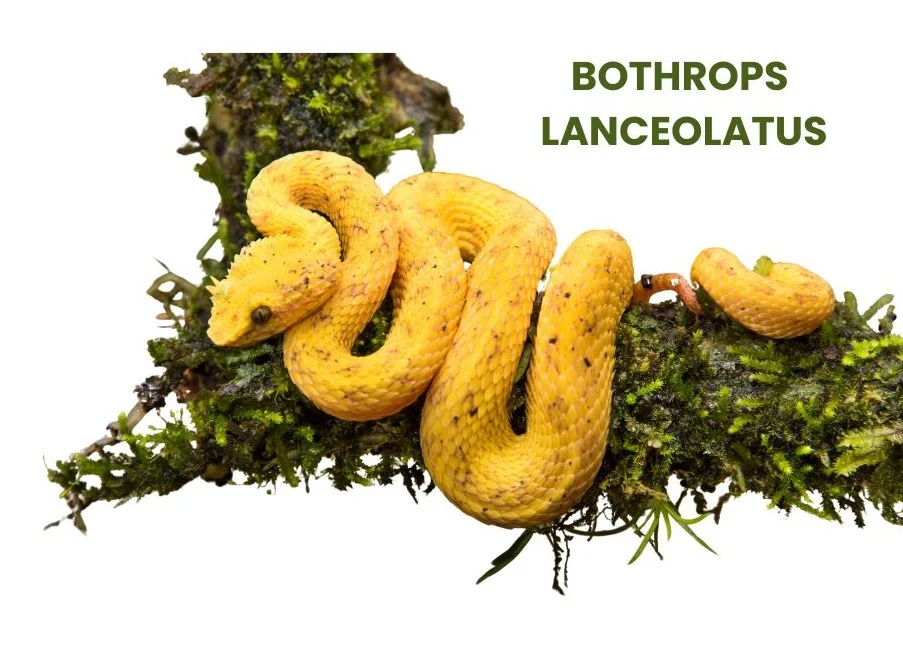Bothrops lanceolatus is a homeopathic remedy derived from the venom of the Yellow Viper.
It is primarily indicated for conditions characterized by thrombotic phenomena, hemorrhages, and septic states.

Table of Contents
ToggleSOURCE INFORMATION
Scientific Classification
- Kingdom: Animalia
- Phylum: Chordata
- Class: Reptilia
- Order: Squamata
- Family: Viperidae
- Genus: Bothrops
- Species: Bothrops lanceolatus
Origin
- Bothrops lanceolatus, commonly known as the Yellow Viper or Lancehead, is a venomous pit viper species native to the island of Martinique in the Lesser Antilles.
- The species is endemic to Martinique and is found in various habitats on the island, including forests, grasslands, and agricultural areas.
Historical Facts
- Bothrops lanceolatus has been historically significant due to its potent venom, which is known for its coagulating properties.
- The venom of the Yellow Viper has been studied for its medicinal potential, particularly in treating thrombotic conditions.
- The species has been a subject of scientific research and conservation efforts due to its unique ecological role and the importance of understanding its venomous properties.
Other Notes
- Bothrops lanceolatus is closely related to other species within the Bothrops genus, such as Bothrops atrox and Bothrops asper, which are found in other regions of Central and South America.
- As a venomous snake, Bothrops lanceolatus plays a crucial role in the ecosystem as both a predator and prey species, contributing to the balance of local biodiversity.
DRUG PATHOGENESIS
The venom of Bothrops lanceolatus is known for its coagulating properties, leading to thrombotic manifestations such as hemiplegia, aphasia, and inability to articulate.
It affects the circulatory system, causing hemorrhages from various orifices of the body and black spots.
KEY CHARACTERISTICS
Haemorrhagic Constitutions and Septic States
- Bothrops lanceolatus is associated with hemorrhagic constitutions, where there is a tendency for excessive bleeding, and septic states, indicating infection and toxicity.
Lassitude and Sluggishness
- Patients may experience great lassitude and sluggishness, indicating a general feeling of fatigue and weakness.
Haemorrhage from Every Orifice
- Hemorrhages may occur from various parts of the body, including mucous membranes, indicating a profound coagulation disorder.
Black Spots
- Black spots may appear on the skin, suggesting areas of necrosis or tissue damage.
Hemiplegia with Aphasia
- Hemiplegia, or paralysis of one side of the body, may occur along with aphasia, the inability to articulate words, without any direct involvement of the tongue.
Nervous Trembling
- Patients may experience trembling or shaking, indicating a state of nervousness or anxiety.
Pulmonary Congestion
- There may be congestion in the lungs, possibly leading to respiratory difficulties.
ORGAN SYMPTOMS
- Eyes: Amaurosis (blindness), blindness from hemorrhage into the retina, and hemeralopia (day blindness) may occur, possibly leading to vision impairment.
- Face: The face may become swollen and puffy, with a besotted expression, suggesting a state of intoxication or poisoning.
- Throat: Throat symptoms may include redness, dryness, constriction, and difficulty swallowing liquids.
- Stomach: Symptoms may include epigastric distress, black vomiting, intense hematemesis (vomiting blood), and tympanitis (distension of the abdomen) with bloody stools.
- Skin: The skin may appear swollen, livid, and cold, with hemorrhagic infiltration, indicating bleeding beneath the skin. Gangrene, swollen lymphatics, anthrax, and malignant erysipelas may also occur, suggesting severe tissue damage and infection.
MODALITIES
- Symptoms are worse on the right side of the body.
RELATIONSHIP WITH OTHER DRUGS
Toxicophis (Moccasin Snake)
- Bothrops lanceolatus shares similarities with Toxicophis, also known as the Moccasin Snake.
- After a bite from this snake, patients may experience pain and fever that recur annually.
- Symptoms may change location or disappear and reappear.
- Dryness of the skin is noted after the bite.
- Additionally, patients may experience edematous swellings and periodical neuralgia.
- Pain from the bite may travel from one part of the body to another.
- These similarities suggest that Bothrops lanceolatus and Toxicophis have overlapping symptomatology and may complement each other in certain cases.
Lachesis
- Bothrops lanceolatus is also compared to Lachesis, another snake poison.
- Lachesis is known for its hemorrhagic and septic effects, similar to Bothrops lanceolatus.
- Both remedies may exhibit symptoms such as bleeding tendencies, septic states, and neurological manifestations.
- This comparison highlights the potential for using Lachesis as a complementary remedy in cases where Bothrops lanceolatus is indicated, further emphasizing their similarities in symptomatology.
Trachinus (Stingfish)
- Bothrops lanceolatus is compared to Trachinus, the Stingfish.
- Both remedies may produce intolerable pains, swelling, acute blood poisoning, and gangrene.
- This comparison suggests that Bothrops lanceolatus and Trachinus may share some common symptoms related to pain, swelling, and tissue damage.
- However, the specific manifestations and modalities of these symptoms may vary between the two remedies.
DOSE
- Recommended doses range from the sixth to thirtieth potency.
Meaning of Difficult Words
- Thrombosis: Formation of blood clots within blood vessels.
- Hemiplegia: Paralysis affecting one side of the body.
- Aphasia: Impairment of language function, affecting the ability to articulate.
- Haematemesis: Vomiting of blood.
- Tympanitis: Inflammation of the tympanic membrane or eardrum.
- Gangrene: Death and decay of body tissue due to insufficient blood supply.
- Erysipelas: Acute bacterial infection of the skin and underlying tissues.
Frequently Asked Questions
What is Bothrops lanceolatus?
- Bothrops lanceolatus is a homeopathic remedy derived from the venom of the Yellow Viper, native to Martinique.
What are the key characteristics of Bothrops lanceolatus?
- Key characteristics include hemorrhages from various orifices, hemiplegia with aphasia, black vomiting, and intense hematemesis.
How does Bothrops lanceolatus affect the body?
- It primarily affects the circulatory system, causing thrombotic phenomena, hemorrhages, and septic states.
What are the recommended doses of Bothrops lanceolatus?
- Doses typically range from the sixth to thirtieth potency in homeopathic practice.
